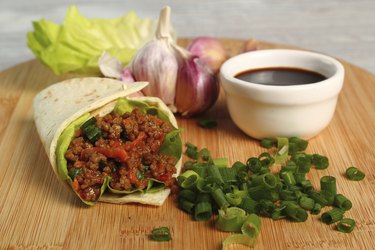
Bamboo is the "everything" grass -- used for flooring, furniture, cookware and for durable, attractive cutting boards. The tough, woody fiber of bamboo is sustainable; the plants mature in a couple of years, unlike hardwood trees that take decades to replace. A bamboo cutting board is an investment that requires very little maintenance, but there are things you can do to prolong the board's life and good looks.
Keep It Clean
Video of the Day
Bamboo's tight grain and hardness make it one of the safest cutting boards you can use. Scarring from knives and the reaction to water and steam create nicks and microscopic cracks in cutting boards where bacteria can grow. While bamboo is naturally resistant to scarring and does not absorb water readily, it is a fiber and does need minimal cleaning and care. Wash the board after use with warm or hot water and soap and rinse. Wipe off the water and let the board air dry. To kill bacteria, clean it with a very diluted solution of 1 tablespoon of bleach in a gallon of water, and then rinse.
Video of the Day
Avoid Machines
Don't put your bamboo cutting board in the dishwasher. The sustained water and heat could cause it to warp or crack. And keep it out of the microwave. There's no reason to stress the board's fiber by subjecting it to that much heat, hastening drying and possible cracking. Regular washing and maintenance will kill or inhibit bacteria. Don't rest a hot pot on the board unless you want to risk a burn mark, which will have to be sanded off.
Oiled and Spoiled
Protect the fibers of the bamboo board from drying with a light coating of food grade mineral oil. Food grade oil is a safe extraction of the petroleum product, and you can find it cheaply at a pharmacy. A light rubbing with the oil before the first use of the board, and a refresher when the surface begins to look dry or worn, keeps the board in good shape. Don't use food oils such as vegetable and olive oils -- they become rancid quickly and will grow rather than inhibit bacteria on your cutting board.
Separate and Safer
Safe protocol for any cutting boards is to separate those used to cut raw meats and fish from those used for vegetables and breads. Salmonella bacteria on meat could seep into microscopic dings and fissures in the board and be transferred to your hothouse tomatoes when you chop the salad. Don't take chances. Keep distinct boards, and follow safe cleaning methods to protect yourself and those you are feeding.
Wet and Warped
It takes work to warp a bamboo cutting board, but it is possible. There is no guaranteed method for reversing a warped cutting board, but you could try the trick that can work for wood boards. Soak the board thoroughly by immersing it in warm or hot water in the sink. Place it on a completely flat surface with a flat board on top of it and weight the board heavily. Free weights, stones, bricks or a major stack of books might do it, but the weight must be really heavy. Leave the cutting board to reshape itself as it dries. And then keep it out of the dishwasher.